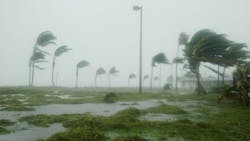Weathering the Storm: A Decade of Experience in Florida's Vegetation Management
While working in Florida’s tree industry since the late nineties, I've become intimately familiar with hurricanes and the challenges they bring. Over the years, I've experienced several scenarios – from being out in the field to coordinating crews during the chaos of storm damage. Working through a storm while living through one is a unique experience and not limited to vegetation management.
Hurricanes are a part of life in Florida and personal encounters can hit close to home. Despite having professional expertise, navigating the aftermath of a hurricane at home often brings its own set of challenges.
Over the past 26 years, I’ve only experienced one hurricane that affected me personally. With damage to my house and two weeks without power, I found myself showering at the office and prioritizing work over personal affairs.
The key, I've learned, is to compartmentalize – focusing on the tasks at hand until the storm passes and then addressing personal matters in what seems like a delicate balancing act. Sometimes you have to shut off the home stuff to focus on the task at hand, which is easier than you’d think due to the amount of work needed.
Preparation is paramount in vegetation management before a storm hits. Leading up to a weather event, my team and I meticulously inspect critical infrastructure and ensure power to essential facilities like police stations and schools. Once the storm approaches, preparations shift to securing personal homes before hunkering down for the duration.
Post-storm, the real work begins. Coordinating crews and resources amidst the chaos becomes the top priority. Safety is always at the forefront of our minds, staying organized is crucial for success, and being adaptable plays a vital role in restoration efforts.
Safety first. Ensuring safety is our top priority in vegetation management, especially when dealing with the aftermath of a storm. It's essential to know what to watch out for because encountering downed power lines is almost guaranteed. Regardless of the situation, treating these lines as live and dangerous is a must. Our goal is to ensure that every member of our team gets home safely at the end of the day.
Organization second. Staying organized is key to handling the many moving parts that follow a storm. Things can get pretty overwhelming with tasks piling up and information coming from every direction. That's why it’s important to emphasize keeping everything well-documented and organized. By maintaining detailed records of work orders, safety procedures, and communication with utility companies and contractors, we ensure that nothing slips through the cracks.
Adaptability is key. Being adaptable is crucial when facing the unpredictability of the restoration process. As someone who's been in the thick of it, I've learned firsthand the importance of flexibility in these situations. You're constantly having to switch gears, sometimes multiple times in a single day. It's natural to feel overwhelmed, but it's essential to speak up and ask for help when needed. Keeping a level head and staying focused is key, especially when coordinating with different utility companies and contractors who may not be familiar with our processes.
The extended hours when working a storm affect everyone differently. Some people combat the fatigue, while others take short breaks, like a few minutes in the truck or a couple of hours at home. Regardless of everyone’s coping methods, every worker is required to take a mandatory eight-hour break each day.
What’s important is that teams prioritize physical and mental health and support each other when working together towards a common goal.
In my role as assistant operations manager, my responsibilities extend beyond fieldwork. I support my team, ensuring they have everything they need to stay on track.
Despite the hurdles we face, I find pride in the bond I share with my team and the understanding that our efforts have a meaningful impact. Whether we're restoring power and bringing stability back to communities or simply carrying out our routine vegetation management duties, knowing that we're making a difference fuels our sense of purpose and drives us forward.
As Florida and the rest of the country continue to face the threat of severe weather events, it’s important to meet each challenge head-on to ensure that our local communities are supported in their time of need.
Lenora Chase is an assistant operations manager at ACRT and has 26 years of industry experience. She is an International Society of Arboriculture (ISA) Certified Arborist and serves on the ACRT Ready Force team.
About the Author
Lenora Chase
Lenora Chase is an assistant operations manager at ACRT and has 26 years of industry experience. She is an International Society of Arboriculture (ISA) Certified Arborist and serves on the ACRT Ready Force team.
